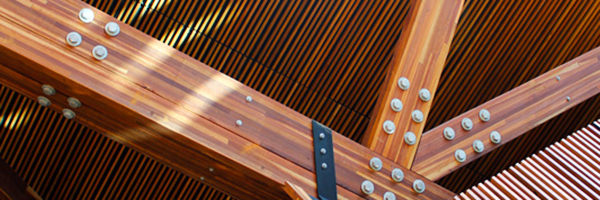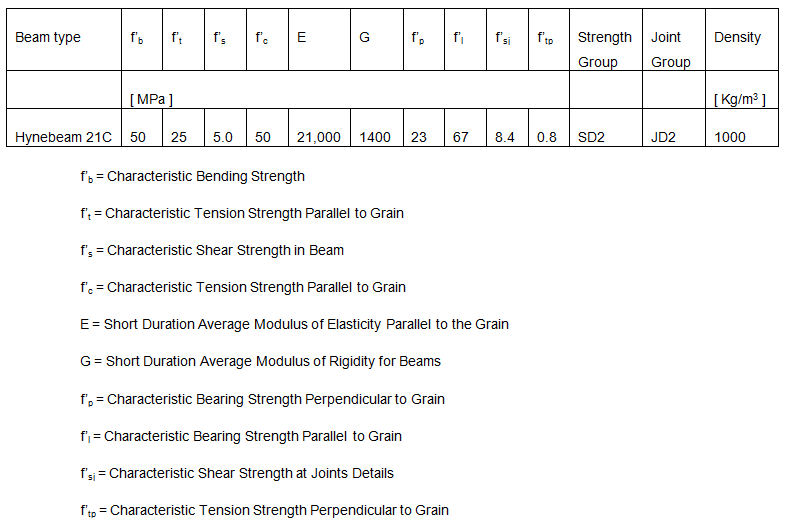
High Strength Timber Beams
Hyne Beam 21 is our premier laminated timber beam designed specifically for high load, appearance applications. Produced from rich coloured and textured Queensland hardwoods, Hyne Beam 21 is naturally durable and termite resistant.
For builders, Hyne Beam 21 is known as our original engineered and glue laminated hardwood beam with a superb record for strength and performance.
Engineers have found Hyne Beam 21 can substitute for steel in many applications where high loads are supported, while architects and designers favour Hyne Beam 21 in appearance applications. Exhibiting deep rich colours, architecturally the intrinsic characteristics of these beams offers unequalled opportunities for creative design.
Mainly available in appearance grade, Hyne Beam 21 is made to order. Timber merchants and other timber suppliers can source their specific job lot requirements from Hyne Wholesale.
Hyne Beam 21 is produced from renewable resources protecting our environment for future generations.
Application
Main product application >
Roof beams, bearers, columns, rafters, lintels.
Size, grades and tolerance
Stock length including increments >
Up to 15.6 m in 0.3m increments
Size range (mm) >
| Thickness | Depth |
| 65 | 120, 155, 185, 215, 245, 280, 300, 315, 350, 380, 410 |
| 85 | 120, 155, 185, 215, 245, 280, 300, 315, 350, 380, 410, 445, 475, 505, 535, 570, 600 |
Tolerance on Section >
| Depth | Tolerance |
| <50mm | ± 0mm |
| <100mm | ± 1mm |
| <150mm | ± 2mm |
| <300mm | ± 3mm |
| <450mm | ± 4mm |
| <600mm | ± 5mm |
| <601mm | ± 6mm |
Thickness – 2mm
Grades >
Hynebeam 21 is available as A Appearance and C Structural Grade
(STR) as defined in AS1328.1.
Select Grade specified as (SEL)
This beam is equivalent to appearance Grade A: AS 1328.1 – 1998. This grade is intended for use in applications where appearance of the member is important and clear or painted finishes are used. All surface voids are therefore filled or repaired. Unless otherwise specified, the surfaces are sanded to a minimum 60 grit finish.
Structural Grade specified as (STR)
This beam is equivalent to appearance grade C: AS 1328.1 – 1998. This grade is intended for use in applications where appearance is not important. All blemishes and voids are acceptable.
Product information:
Species specification >
The species used consists of visual graded Spotted Gum, Red and Grey Ironbark, Blackbutt, Forest Red Gum and Gympie Messmate.
Adhesive specification >
Resorcinol based glues (PRF – Phenol Resorcinol Formaldehyde) are used which are suitable for Service Class 3.
Moisture content >
Basic definition
Moisture content is the mass of moisture present in wood divided by the mass of the wood with no moisture in it, expressed as a percentage.
Moisture content range
The moisture content of Hynebeams has a range of between 8-15%.
The moisture content is uncorrected. Therefore moisture meters used to confirm the moisture content need be set to Douglas-fir and 20ºC which are the default setting for most moisture meters.
Treatment and Durability:
Treatment options >
| Species | Lyctid susceptibility of sapwood | Natural Durability class of heartwood | Termite Resistance of Heartwood | |
| In-ground contact | Outside above ground | |||
| Spotted Gum (Corymbia maculata, Corymbia citriodora, Corymbia henryi) | Susceptible | 2 | 1 | Resistant |
| Red Ironbark (Eucalyptus sideroxylon) | Susceptible | 1 | 1 | Resistant |
| Grey Ironbark (Eucalyptus drepanophylla, Eucalyptus paniculata) | Not Susceptible | 1 | 1 | Resistant |
| Blackbutt (Eucalyptus pilularis) | Not Susceptible | 2 | 1 | Resistant |
| Forest Red Gum (Eucalyptus tereticornis, Eucalyptus blakelyi) | Not Susceptible | 1 | 1 | Resistant |
| Gympie Messmate (Eucalyptus cloeziana) | Not Susceptible | 1 | 1 | Resistant |
Note: Species with Lyctid susceptible sapwood are treated to ensure sapwood is not susceptible to lyctid attacks up to H3 level.
Source: AS 5604-2005 (Incorporating Amendment No. 1) Timber-Natural durability ratings
Maintenance >
Please refer to Hyne Technical Data Sheets In weather exposed applications (TDS6), Sealing, painting or varnishing (TDS8) and Hyne ETP Design for Durability (TDS9).
Service Classes >
Service Class 1 – Service Class characterized by a moisture content in the materials corresponding to a temperature of 20ºC and relative humidity of the surrounding air only exceeding 65% for a few weeks per year.
Note: On Service Class 1 the average equilibrium moisture content in most glulam will not exceed 12%.
Service Class 2 – Service Class characterized by a moisture content in the materials corresponding to a temperature of 20ºC and relative humidity of the surrounding air only exceeding 85% for a few weeks per year.
Note: On Service Class 2 the average equilibrium moisture content in most glulam will not exceed 20%.
Service Class 3 – Service Class characterized by climatic conditions leading to higher moisture contents than Service Class 2, or where timber is directly exposed to sun and/or rain.
Note: Refer to additional technical Information sheet.
Source: AS/NZS1328.1 – 1998 Glued laminated structural timber – Performance requirements and minimum production requirements
Design information:
Design properties >
Mechanical properties have been determined in limit state format form with a comprehensive testing and evaluation program carried out by Hyne. The modulus of rigidity is calculated by using G = E/15.
Density is a measured property and is determined as average seasoned density. However properties such as Bearing Strength Perpendicular to Grain, Bearing Strength Parallel to Grain, Shear Strength at Joints Details and Tension Strength Perpendicular to Grain are secondary properties which are depending on the strength group for the material and are determined in accordance with AS1720.1-2010. Further joint group are based on the material used and the groups are defined based on species and density as per AS1720.1-2010.
Characteristic properties for Hynebeam 21C >

Values of capacity factor (F) for calculating the design capacity of (F Rd) of structural members >
| Structural Material | Application of structural member | ||
| Structural members for house for which failure would be unlikely to affect an area* greater than 25 m2; | |||
OR
secondary members in structures other than housesPrimary structural elements in structures other than houses
OR
elements in houses for which failure would be likely to affect an area* greater than 25m2Primary structural members in structures intended to fulfil an essential service or post disaster functionValues of capacity factor, FGlue-laminated timber-AS/NZS 1328 .10.950.850.75
* In this context, area should be taken as the plan area.
Source: AS1720.1 – 2010 Timber Structures Part 1: Design methods
Duration of load factor (j2) for creep deformation >
| Load Duration | Service Class/Exposure Classification | ||
| 1 & 2 | 3 | Severe/Adverse | |
| Short Term ? 1 day | 1.0 | 1.0 | 1.0 |
| Long Term ? 1 year: | |||
Section width > 45mm1.52.03.0*Long Term ? 1 year:
Section width ? 45mm2.02.03.0*
Source: GLTAA Technical Data Sheet No.
3 Unified Design Criteria.
The engineering design data presented may be used for structural design of domestic, commercial and industrial applications in conjunction with:
- AS1684.1 – 1999 Residential timber-framed construction Part 1 Design Criteria
- AS1720.1 2010 – Timber Structures Part 1: Design methods
- GLTAA (Glued Laminated Timber Associated of Australia) Uniform Design Criteria,
and all other relevant standards (e.g. loading codes, wind codes, etc.).
Conductivity k >
For moisture contents below 25%, approximate thermal conductivity k across the grain can be calculated with a linear equation of the form
K = Gx(B + CX) + A
where Gx is specific gravity based on ovendry mass and volume at moisture content x (%) and A, B, and C are constants.
For Gx > 0.3, temperatures around 24 ºC, and x < 25% MC, the values of the constants are as follows:
A = 0.01864, B = 0.1941, C = 0.004064 (k in W m-1 K-1)
Camber
Hynebeams with “C”
designates a Hynebeam with a vertical camber radius of curvature of 600mm. “S” designates a straight Hynebeam.
Alignment and tolerance of both straight and cambered beams shall be no more than 1mm per metre of length of beam.
Hyne Beams are generally supplied as cambered marked to identify the top edge of the beam. Unless specifically requested (such as for large cantilevers), this brand should not be installed facing downwards.
The below table displays the amount of camber versus beam length.
| Beam length (m) | 2.4 | 2.7 | 3.0 | 3.3 | 3.6 | 3.9 | 4.2 | 4.5 | 4.8 | 5.1 | 5.4 |
| Camber (mm) |
1.2 | 1.5 | 1.9 | 2.3 | 2.7 | 3.2 | 3.7 | 4.2 | 4.8 | 5.4 | 6.1 |
| Beam length (m) | 5.7 | 6.0 | 6.3 | 6.6 | 6.9 | 7.2 | 7.5 | 7.8 | 8.1 | 8.4 | 8.7 |
| Camber (mm) |
6.8 | 7.5 | 8.3 | 9.1 | 9.9 | 10.8 | 11.7 | 12.7 | 13.7 | 14.7 | 15.8 |
| Beam length (m) | 9.0 | 9.3 | 9.6 | 9.9 | 10.2 | 10.5 | 10.8 | 11.1 | 11.4 | 11.7 | 12.0 |
| Camber (mm) |
16.9 | 19.0 | 19.2 | 20.4 | 21.7 | 23.0 | 24.3 | 25.7 | 27.1 | 28.5 | 30.0 |
| Beam length (m) | 12.3 | 12.6 | 12.9 | 13.2 | 13.5 | 13.8 | 14.1 | 14.4 | 14.7 | 15.0 | 15.3 |
| Camber (mm) |
31.5 | 33.1 | 34.7 | 36.3 | 38.0 | 39.7 | 41.4 | 43.2 | 45.0 | 46.9 | 48.8 |
| Beam length (m) | 15.6 | 15.9 | 16.2 | 16.5 | 16.8 | 17.1 | 17.4 | 17.7 | 18.0 | 18.3 | 18.6 |
| Camber (mm) |
50.7 | 52.7 | 54.7 | 56.7 | 58.8 | 60.9 | 63.1 | 65.3 | 67.5 | 69.8 | 72.0 |
Hynebeams 21 have a lamination thickness of 30mm.
Standards:
Manufacturing standards
TAS/NZS 1328.1 – 1998 Glued laminated structural timber Part 1: Performance requirements and minimum production requirements
AS 5068 – 2006 Timber – Finger joints in structural products – Production requirements
Design Standards
AS1684.1-1999 Residential timber-framed construction – Design criteria
AS1720.1-2010 – Timber structures Part 1: Design methods
Third Party Information:
Hyne Glulam Maryborough has an accredited Quality assurance in place meeting ISO 9001.
Click below to find out more or contact us on: John Carroll 0414301515 and Colin Carroll 0421273887
Email for a price or more information: John@carrollswholesale.com, Colin@carrollswholesale.com

Leave a Reply
Want to join the discussion?Feel free to contribute!